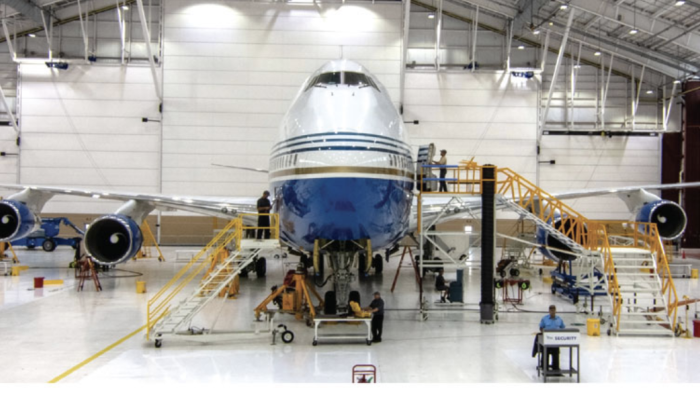Air Services, Constant Aviation’s mobile aircraft recovery team, grew out of a 2004 accident on Cleveland Hopkins Airport in which a taxiing Embraer ERJ135 hit the tail of another taxiing aircraft with its wing.
“The incident resulted in an insurance repair,” said Steve Maiden, Constant Aviation’s president. “We saw what happened; it was on our ramp. Both aircraft were substantially damaged, so we decided we’d bid on the work. It was was an arduous process to work through: the quoting, the required engineering, and the process involved to secure the necessary parts.”
After the project was completed in 2005 it occurred to Maiden that there weren’t many facilities that could handle such a project. “There didn’t appear to be any operators that specialized in that type of situation. By then we had acquired the complex experience necessary to take on such a project and we saw an underserved niche market,” he told AIN.
Today Air Services specializes in repairing and recovering aircraft anywhere, any day, any time. “We can do the smallest job or the largest anywhere,” said Maiden.
The actual repair portion of a project is the easy part, according to the Constant executive. “It’s a process a lot of MROs don’t understand. We definitely went through a little bit of pain on that first project, but we came out with substantial experience in the process of recovering damaged aircraft. What we’ve discovered is it’s one thing to have this happen in your backyard where you have a semblance of control but another to go to a remote location like Brazil and accomplish the same process,” Maiden said, referring to Air Service’s recovery of the Legacy 600 that survived a collision with a Gol 737 over the jungles of Brazil in September 2006.
“We learned some interesting lessons by doing a remote location. The protocol of operating in a foreign country, how you get people in and out of the country, working with foreign regulations, even the customs process to ship parts in and out of a country, can be challenging.”
Maiden said the process of recovering an aircraft from a remote location focuses on planning. “You have to think of every eventuality in advance and take everything with you that you’re going to need to do the project. When you’re in a remote international location you have to plan for every possibility because getting it once you’re there can be a major problem. Overnight services don’t go into remote locations,” he said.
Based Support
The mobile aircraft recovery team is backed by Constant Aviation’s 115,000-sq-ft hangar and office complex in Cleveland of which 60,000 sq ft is dedicated to maintenance covering three hangar bays. There is also 15,000 sq ft dedicated to a composite and accessory shop. An additional 75,000 sq-ft operation is located in Birmingham, Ala., which includes 50,000 sq ft dedicated to maintenance.
Maiden said no two events are the same. The process is similar but the individual issues are different for every situation. “There is no one size fits all. Each event has to be planned based on individual circumstances, and the sooner we get involved the better it will be. We like to get into the process early on and work with the insurer and client well in advance of going to the aircraft location,” he said.
“It has been our experience that the majority of our repairs have to be conducted on location. As a result we have put together a dedicated team that includes structures mechanics, avionics technicians and an engineering team with DER and DAR capability in addition to A&P mechanics,” he said.
According to Maiden, Air Services will dispatch a small team to a location to check out the status of the aircraft and the scope of the work required. When they return it takes about another two weeks to do the planning and bring the necessary resources together for the job. At that point a team of five to eight technicians will be dispatched to the site and will spend as many as as 80 days doing the work.
Maiden said, “When you consider the work requirement, the transportation, housing and general logistical support, the planning required comes out to be about 40 percent of the job. The challenge is to plan it all as quickly and efficiently as possible.
“We’ve invested heavily in bringing the right people and resources together to undertake this type of complex recovery. Considering our technicians’ experience, our technical capability and experience with logistical planning, we estimate we cut the aircraft down time by more than 20 percent,” he said.
According to Maiden, the mobile aircraft recovery team can work on any corporate or regional airframe ranging from a CJ to an E190. “Our core capabilities include the Citation series, Beechjet 400A/XP, Hawker 800A/XP, Piaggio P180, King Air series, Embraer Legacy 600 and Gulfstream. Our core capability within our commercial maintenance division is on the CRJ200/700/900 and ERJ135/145.”
The Air Services dedicated team has grown from five to 20 since it was formed and Maiden said they are routinely working two or three projects at a time. “We do anything from one- to two-day structural repairs to the largest recoveries that have taken up to 80 days. Insurance carriers insure both commercial and corporate aircraft. As a result, we’ve become first reponders for the majority of insurers and have been dispatched on recovery projects ranging from a Citation in Mexico to an Embraer E190 in New Jersey. We’re offering a service that few, if any, can provide.”







